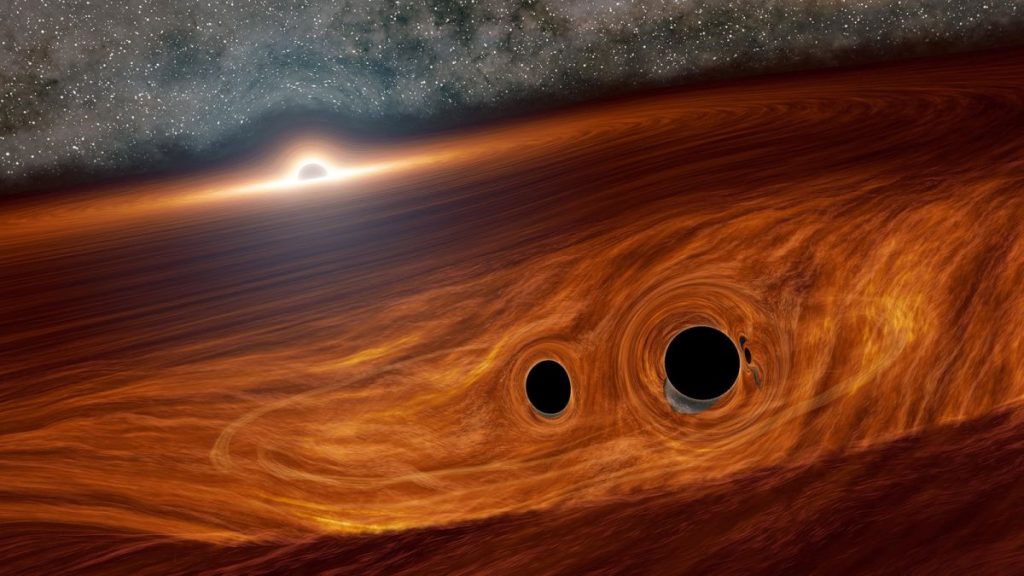
How dancing black holes get close enough to merge (Image Credit: Space.com)
The many black hole mergers detected through gravitational wave observatories have revealed that black holes crash into each other far more often than we thought. Now, new research suggests a way for black holes to merge quickly: They must be caught in the accretion disk of a supermassive companion.
It’s relatively easy, astrophysically speaking, to get two black holes close to each other. Either they are born that way as the offspring of a binary star system, or they randomly encounter each other in the depths of interstellar space. And once in orbit, they can remain so, circling around each other endlessly.
Even before the detection of gravitational waves from merging black holes, astronomers knew that binary orbiting black holes eventually met a fatal end. We know that large galaxies grow from the collective merging of many smaller galaxies and that almost every galaxy in the universe hosts a giant black hole in its center. But usually, each galaxy has only one giant black hole, telling us that if galaxies merge, then so too must their black holes.
Related: Watch two monster black holes merge into one in this intricate NASA simulation (video)
But getting black holes to smash into each other is pretty challenging. To bring two orbiting objects closer together, you have to suck energy and angular momentum away from the system. Because space is pretty frictionless, this is a tough job. Planetary systems do this all the time, but it usually involves the emission of radiation or the presence of gas. Black holes have no such option.
Gravitational waves can pull energy and momentum out of a binary system, but because gravitational waves are so weak, this process works well only when the two black holes are already very close to each other. This is known as the “final parsec problem,” whereby astronomers have recognized the difficulty in getting binary black holes close enough to let gravitational waves do the rest of the work in driving the merger.
Solving the final parsec problem
Over the years, astronomers have come up with a variety of ways to solve the final parsec problem. These mechanisms have usually involved the presence of a third object well beyond the mutual orbit of the binary pair. If the conditions are right, with just the right alignments and speeds, the third companion can gently tug on the binary, stretching out their orbit. That stretching increases the ellipticity of the binary black hole orbit. With the increased ellipticity, the black holes start to spend more and more of their time close together. Once they reach a critical distance, gravitational waves close the gap and the black holes finally merge.
But that scenario requires a precise configuration for the third companion, and it may not be enough. Based on all the observations of gravitational waves, astronomers estimate that there are somewhere between 15 and 38 black hole mergers every year within every cubic gigaparsec of volume in the universe (about 1/12000th of the total volume of the observable universe), and mechanisms that rely on a third companion produce less than half that number.
In a new paper published in the preprint database arXiv (opens in new tab), researchers propose a new way for black holes to merge. It, too, uses a somewhat specific setup, but it’s much more generic than the reliance on a distant third companion.
The setup starts near a supermassive black hole. This isn’t a crazy idea, since supermassive black holes sit in the centers of galaxies, which are crammed with stars and hence many smaller black holes. As with most things near the center of the galaxy, we can probably find many binary black holes lazily orbiting the central supermassive one.

The authors of the paper discovered that if the binary is tilted with respect to its orbit around the supermassive black hole, there’s a chance to set up a merger. First, the binary pair needs to precess, which means the axis of their orbital rotation wobbles over time. If the rate of that precession matches the orbital period around the central supermassive black hole, then its enormous gravity will regularly tug on the binary, causing their eccentricity to increase and heightening the chances of a final merger.
But that kind of matching can happen only if the orbit of the binary around the central supermassive black hole is exactly right, and that has to be a very lucky coincidence. Thankfully, the authors found that nature can take care of that. Wherever the binary black holes are born, if they are in the disk of the supermassive black hole, they will slowly migrate inward.
No matter their starting orbit, they will eventually find a distance where their orbital period matches their precession period. If they hang out in that orbit long enough, the gravity of the central supermassive black hole will have sufficient time to increase the eccentricity.
The authors found that this is a rather generic scenario. By running many simulations of black hole properties and starting conditions, they discovered that binary black holes routinely merge.
It’s not yet clear if this is the primary mechanism by which mergers take place, or if it’s just one of the many ways. Regardless, the work shows just how complicated the lives of black holes can be and the many ways they can dance in the dark.
Follow us on Twitter @Spacedotcom and on Facebook.
Learn more by listening to the “Ask a Spaceman” podcast, available on iTunes (opens in new tab)and askaspaceman.com (opens in new tab). Ask your own question on Twitter using #AskASpaceman or by following Paul @PaulMattSutter (opens in new tab)and facebook.com/PaulMattSutter (opens in new tab).
Follow us on Twitter @Spacedotcom (opens in new tab) or on Facebook (opens in new tab).





